Reviewed on PC.
You know those days where nothing goes right? When you’re late to work, then you accidentally release a bunch of homicidal aliens, then the military turns up to execute everyone? No?
Half-Life is a 1998 first person shooter that had a massive influence on games that came after it. It pushed away from the waves of Doom-clones with the goal of delivering a more realistic and cinematic experience. You play as Gordon Freeman, a scientist who works at the Black Mesa facility, and tries to repel the alien threat unleashed after an experiment goes wrong. The story isn’t groundbreakingly original, but what was notable at the time was the fact the narrative is delivered by listening to NPCs and observing events in-game, rather than through cutscenes. This makes the game feel like an unbroken experience, instead of game levels divided up by plot dumps.
The game features a good variety of environments, including a labs with little puzzles to solve, areas swamped by hazardous chemicals, a rail system with a cart you can ride and the desert outside the facility. The areas don’t usually feel like believable spaces, but you feel a sense of momentum and regularly see something new to keep things interesting.
Half-Life is a shooter, so unsurprisingly, it has shooting. The game gives you the expected melee weapon, pistol, shotgun and so on, along with more unusual arms like a gauss cannon and a crossbow, and Freeman is allowed to carry all his arsenal at once, since realistic weapon limits weren’t a thing yet. As for the things receiving the bullets, the aliens are fun to fight and there are plenty of different types to keep things fresh. Fighting the aliens feels satisfying, as the weapons feel suited to combating them; sadly, the same can’t be said of the military enemies. The soldiers don’t react to incoming fire until they drop dead, and they have pretty much perfect aim, meaning some confrontations boil down to the player and the soldier pummelling each other until one drops. Add to this the fact they take a few billion rounds before feeling mildly uncomfortable and the encounters before you find the punchy weapons are pretty punishing. On the flip side, if you are the one with the drop on them, they are completely oblivious to their adjacent squadmate’s head exploding. The AI is usually quite smart, but if the soldiers can’t see you, they are easy to exploit.
As with many games of the late 90s and early 2000s, Half-Life includes platforming as a way to shake things up. This platforming is abysmal. The main problem is the way you move; Freeman runs at a superhuman speed and decelerates, rather than halts, when you stop pressing a movement key. The enemies posed a minimal threat in comparison with Freeman’s hyperactive sliding. During my playthrough, I skidded off a thousand ledges to my death; skidded into missiles; skidded into live grenades and skidded onto mines. First person platforming is awkward at the best of times, and adding unpredictable movement into the mix sometimes make the frustration hard to handle. I later discovered there is a button to fully stop you moving, but it’s pretty unintuitive, and I had usually overshot my target and been injured/killed before I could react. On a similar note, the ladders that do not have a platform opposite them are deathtraps, as heading down them is next to impossible, so you end up with more injuries.
The final few chapters are a let-down. The pace has been ratcheted up and you assume things are about to dramatically conclude, but instead you are greeted by the most unpleasant platforming in the game, with different gravity to the level you spent the last ten hours compensating for, topped off by a liberal helping of projectiles flying at you. One of these levels features throwing your now limited ammo at a giant spider with a huge scrotum, and most of your healing will be done by sitting in pools that give you enough time to do all your chores. While there are some visually interesting aspects to the environments (no I’m not talking about the scrotum spider), the general experience is pretty negative, and Gabe Newell himself stated he regrets the final section.
On the technical side, I didn’t have many problems. I wrote this review in July 2017, and during that month valve released an update fixing a number of bugs. It is extremely rare for a game to receive support nineteen years on, so kudos for that. One issue I did run into was NPCs’ dialogue being too quiet, which meant I missed a lot of exposition and objective updates.
Half-Life is one of the milestones in gaming, and its influence can be felt in most shooters that succeeded it. As a person who played it for the first time in 2017, it’s easy to zone in on the aspects that make its age apparent, but it still has plenty to offer the modern player. I particularly like the tone of the early game, which feels like horror as much as sci-fi. I enjoy the shooting, which is in a sweet spot between arcade-like and believable. Aside from the last few chapters, it also keeps a good pace, periodically introducing new weapons, enemies and environmental problems to keep things moving. Half-Life is still worth a play, even if you ‘weren’t there’, but be prepared for some frustration.
Recommended? Yes
